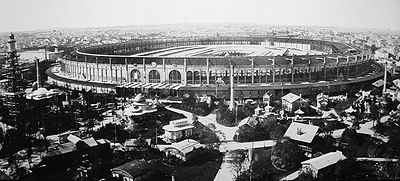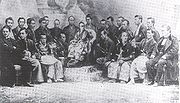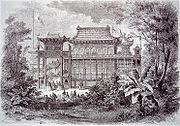
Exposition Universelle (1867)
Encyclopedia




Paris
Paris is the capital and largest city in France, situated on the river Seine, in northern France, at the heart of the Île-de-France region...
, France
France
The French Republic , The French Republic , The French Republic , (commonly known as France , is a unitary semi-presidential republic in Western Europe with several overseas territories and islands located on other continents and in the Indian, Pacific, and Atlantic oceans. Metropolitan France...
, in 1867.
Conception
In 1864, Emperor Napoleon IIINapoleon III of France
Louis-Napoléon Bonaparte was the President of the French Second Republic and as Napoleon III, the ruler of the Second French Empire. He was the nephew and heir of Napoleon I, christened as Charles Louis Napoléon Bonaparte...
decreed that an international exposition should be held in Paris
Paris
Paris is the capital and largest city in France, situated on the river Seine, in northern France, at the heart of the Île-de-France region...
in 1867. A commission
Government agency
A government or state agency is a permanent or semi-permanent organization in the machinery of government that is responsible for the oversight and administration of specific functions, such as an intelligence agency. There is a notable variety of agency types...
was appointed with Prince Jerome Napoleon
Jerome Napoleon Bonaparte II
Jerome Napoleon Bonaparte II was a son of Jerome Napoleon Bonaparte and Susan May Williams.-Biography:...
as president, under whose direction the preliminary work began. The site chosen for the Exposition Universelle of 1867 was the Champ de Mars
Champ de Mars
The Champ de Mars is a large public greenspace in Paris, France, located in the seventh arrondissement, between the Eiffel Tower to the northwest and the École Militaire to the southeast. The park is named after the Campus Martius in Rome, a tribute to the Roman god of war...
, the great military parade ground of Paris, which covered an area of 119 acres (48 ha) and to which was added the island of Billancourt
Billancourt
Billancourt is a commune in the Somme department in northern France....
, of 52 acres (21 ha). The principal building was rectangular in shape with rounded ends, having a length of 1608 feet (490 m) and a width of 1247 feet (380 m), and in the center was a pavilion surmounted by a dome and surrounded by a garden, 545 feet (166 m) long and 184 feet (56 m) wide, with a gallery built completely around it. In addition to the main building, there were nearly 100 smaller buildings on the grounds.
Exhibit
There were 50,226 exhibitors, of whom 15,055 were from FranceFrance
The French Republic , The French Republic , The French Republic , (commonly known as France , is a unitary semi-presidential republic in Western Europe with several overseas territories and islands located on other continents and in the Indian, Pacific, and Atlantic oceans. Metropolitan France...
and her colonies, 6176 from Great Britain
Great Britain
Great Britain or Britain is an island situated to the northwest of Continental Europe. It is the ninth largest island in the world, and the largest European island, as well as the largest of the British Isles...
and Ireland
Ireland
Ireland is an island to the northwest of continental Europe. It is the third-largest island in Europe and the twentieth-largest island on Earth...
, 703 from the United States
United States
The United States of America is a federal constitutional republic comprising fifty states and a federal district...
and a small contingent from Canada
Canada
Canada is a North American country consisting of ten provinces and three territories. Located in the northern part of the continent, it extends from the Atlantic Ocean in the east to the Pacific Ocean in the west, and northward into the Arctic Ocean...
. The funds for the construction and maintenance of the exposition consisted of grants
Grant (money)
Grants are funds disbursed by one party , often a Government Department, Corporation, Foundation or Trust, to a recipient, often a nonprofit entity, educational institution, business or an individual. In order to receive a grant, some form of "Grant Writing" often referred to as either a proposal...
of $1,165,020 from the French government, a like amount from the city of Paris, and about $2,000,000 from public subscription, making a total of $5,883,400; while the receipts were estimated to have been but $2,822,900, thus leaving a deficit, which, however, was offset by the subscriptions from the government and the city of Paris, so that the final report was made to show a gain.
The exposition was formally opened on April 1, and closed on October 31, 1867, and was visited by 9,238,967 persons, including exhibitors and employees. This exposition was the greatest up to its time of all international expositions, both with respect to its extent and to the scope of its plan.
Influences
Vincent Van GoghVincent van Gogh
Vincent Willem van Gogh , and used Brabant dialect in his writing; it is therefore likely that he himself pronounced his name with a Brabant accent: , with a voiced V and palatalized G and gh. In France, where much of his work was produced, it is...
and other artists of the post-impressionism
Post-Impressionism
Post-Impressionism is the term coined by the British artist and art critic Roger Fry in 1910 to describe the development of French art since Manet. Fry used the term when he organized the 1910 exhibition Manet and Post-Impressionism...
movement of the late 19th century were part of the European art craze inspired by the displays seen here, and wrote often of the Japanese woodcut prints "that one sees everywhere, landscapes and figures." Not only was Van Gogh a collector of the new art brought to Europe from a newly opened Japan
Sakoku
was the foreign relations policy of Japan under which no foreigner could enter nor could any Japanese leave the country on penalty of death. The policy was enacted by the Tokugawa shogunate under Tokugawa Iemitsu through a number of edicts and policies from 1633–39 and remained in effect until...
, but many other French artists from the late 19th century were also influenced by the Japanese artistic world-view, to develop into Japonism
Japonism
Japonism, or Japonisme, the original French term, was first used in 1872 by Jules Claretie in his book L'Art Francais en 1872 and by Philippe Burty in Japanisme III. La Renaissance Literaire et Artistique in the same year...
.
Jules Verne
Jules Verne
Jules Gabriel Verne was a French author who pioneered the science fiction genre. He is best known for his novels Twenty Thousand Leagues Under the Sea , A Journey to the Center of the Earth , and Around the World in Eighty Days...
visited the exhibition in 1867, his take on the newly-publicized discovery of electricity
Electricity
Electricity is a general term encompassing a variety of phenomena resulting from the presence and flow of electric charge. These include many easily recognizable phenomena, such as lightning, static electricity, and the flow of electrical current in an electrical wire...
inspiring him heavily in his writing of 20,000 Leagues Under the Sea.
A famous revival of the ballet Le Corsaire
Le Corsaire
Le Corsaire is a ballet typically presented in three acts, with a libretto originally created by Jules-Henri Vernoy de Saint-Georges loosely based on the poem The Corsair by Lord Byron. Originally choreographed by Joseph Mazilier to the music of Adolphe Adam, it was first presented by the ballet of...
was staged by the Ballet Master Joseph Mazilier
Joseph Mazilier
Joseph Mazilier was a 19th-century French dancer, balletmaster and choreographer. He was most noted for his ballets Paquita and Le Corsaire...
in honor of the exhibition at the Théâtre Impérial de l´Opéra on October 21, 1867.
The World Rowing Championships were held on the Seine River
Seine
The Seine is a -long river and an important commercial waterway within the Paris Basin in the north of France. It rises at Saint-Seine near Dijon in northeastern France in the Langres plateau, flowing through Paris and into the English Channel at Le Havre . It is navigable by ocean-going vessels...
in July and was won by the underdog Canadian team from Saint John, New Brunswick
Saint John, New Brunswick
City of Saint John , or commonly Saint John, is the largest city in the province of New Brunswick, and the first incorporated city in Canada. The city is situated along the north shore of the Bay of Fundy at the mouth of the Saint John River. In 2006 the city proper had a population of 74,043...
which was quickly dubbed by the media as The Paris Crew
Paris Crew
The Paris Crew is the name given to a quartet of Canadian sport rowers from Saint John, New Brunswick.Robert Fulton, George Price, Samuel Hutton, and Elijah Ross, along with reserve oarsman James Price, became Canada's first-ever international sporting champions when they defeated the London Rowing...
.

